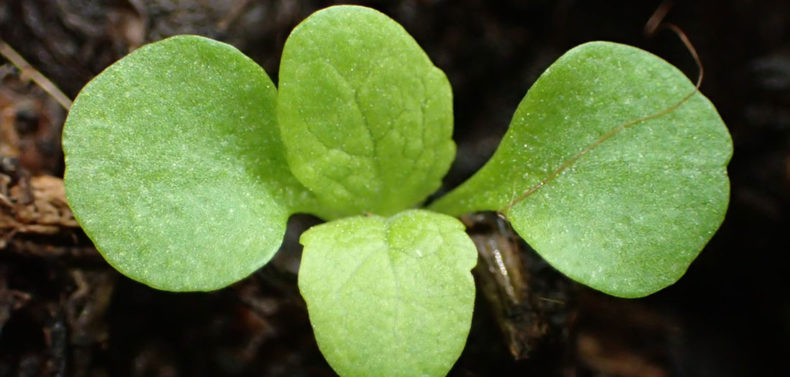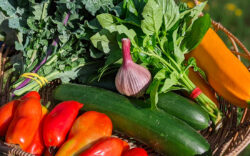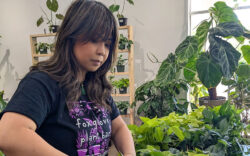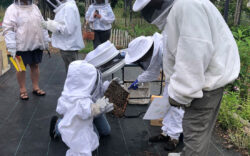Northeast Georgia’s last frost date approaches, thank goodness. Our chance of frost ends Apr. 15, so it’s a great time to seed cold-sensitive annuals like peppers, tomatoes and cucumbers. Best plant your last batch of spring veggies like lettuce, chard, beets or carrots now. They’ll need time to size up before the summer heat blazes.
Can I use seeds I’ve had for a year (or three)?
Yes, with caveats. Seed packets often display germination rates for the year they’re packed. You can expect a broccoli seed packet packed in spring 2019 with a germination rate of 96% to yield about 96 germinated seeds out of 100 in fall 2019. The longer the broccoli seed packet sits in your closet, the lower the germination rate will fall. For greens like lettuce, the germination rate will fall even more quickly over time. Bigger, meatier seeds, like squash or beans, lose germination rates more slowly.
Do I plant seeds in my garden bed or somewhere else before transplanting into the garden bed?
I sow legumes and root crops directly into garden rows. I know farmers who transplant beans, and farmers who transplant beets and other root crops. Try what makes the most sense to you.
Transplants mean a leg up on weeds. That’s especially helpful for long-term crops like eggplants and peppers. Transplanted seedlings out-compete weeds by shading out the area closest to the plant and establishing a robust root system. You can use just about any container to start your seeds (yogurt cups, newspaper pots, standard cell trays, empty beer cans, etc.), but be sure to poke some holes in the bottom for good drainage.
What kind of soil do I use for my seeds?
Gardening centers proffer a dizzying display of seed-sprouting mixes. I am solidly “meh” on all these. I plant sprouted seeds into garden soil that’s a combination of clay and compost. I need them to survive in that environment, so I use that soil to germinate. I do mix a few handfuls of bagged soil with the garden soil when I need to baby some rare or expensive seeds (looking at you, Habanada pepper seeds). I try to use as little peat moss and coconut coir as possible. Peat moss is non-renewable, and coconut coir travels a long way, adding a significant carbon footprint to those products. No shade if you want to use those products, but you don’t need them to have healthy seedlings.
How deep do I plant these seeds?
The rule of thumb I like to follow is two-and-a-half times the width of the seeds. For tiny seeds like broccoli, that’s the depth of a pencil eraser. Squash, a wider seed, gets planted past the thumb knuckle. Lettuce seeds need light to germinate, so I don’t cover them at all. I make a depression in the soil, place the seed in it and water it lightly.
What about soaking seeds overnight? Or scarification?
Scarification is scratching the outside of the seed coating to make it easier and faster for the seed to germinate. Soaking overnight accomplishes a similar purpose. Different seeds prefer different methods to encourage germination.
One man complained about his poor lettuce seed germination after consistently soaking the seeds overnight. He drowned his lettuce seeds and then wondered why he never got any lettuce. Seed packets often include information on good germination practices.
Seeds with a thick coating—think okra, pumpkin and gourd seeds—can benefit from measures such as soaking and scarification. I don’t use either method unless specifically directed by the seed company.
I planted these seeds, and they’re not coming up!
When I’m worried about germination, I dig up a few of the seeds to see what’s happening. A cracked seed shell with a root or tendril is a sign to add patience. One time, I started digging up a sad, empty row, and I couldn’t find any seeds. Then I remembered how many birds I’d seen when I planted that row—I think the birds stole the seeds.
Watering consistently helps. I water my seeds almost every morning, with adjustments made for rain. I grow my first batch of seeds in small containers, so they can dry out fairly quickly with the March winds and Georgia’s warm spring temperatures. Seedlings repotted in 4-inch pots retain water better, so those get a drink every other day.
Seeds can take three days or three weeks to germinate, depending on the type. Beans shoot out of the ground fast. Carrot tops amble along more slowly, often giving me a scare. If your seeds aren’t more than a year old, it might take a little more patience to see your garden grow.
Like what you just read? Support Flagpole by making a donation today. Every dollar you give helps fund our ongoing mission to provide Athens with quality, independent journalism.










